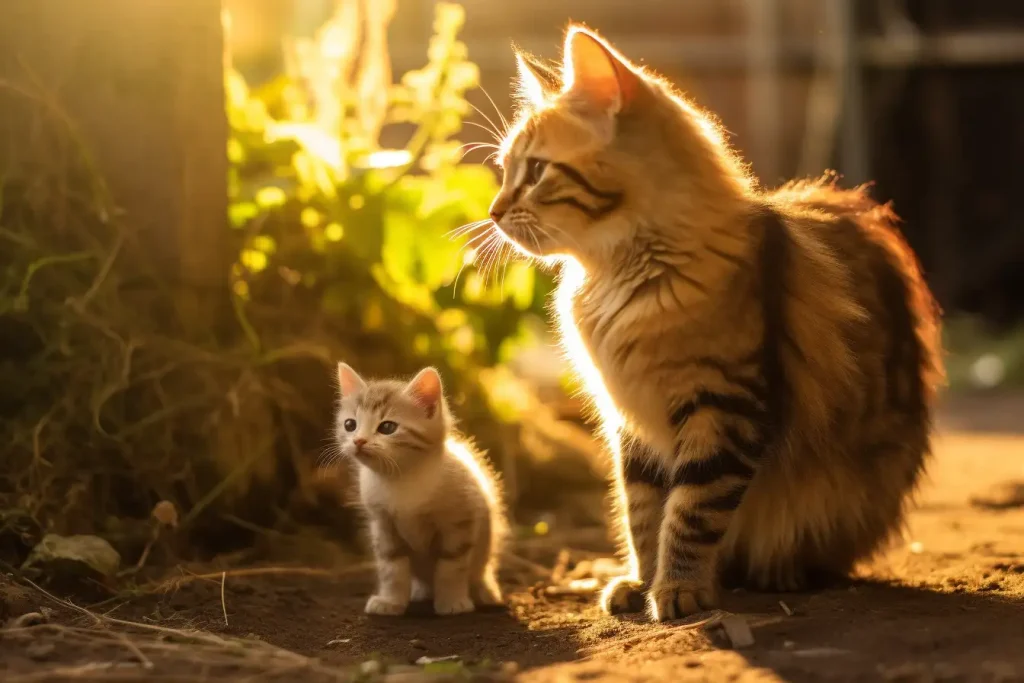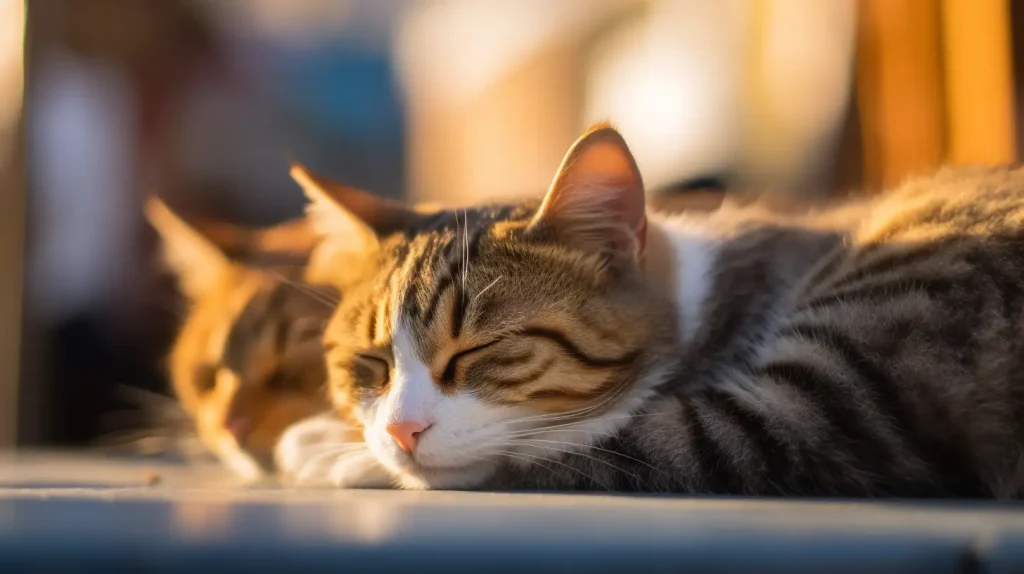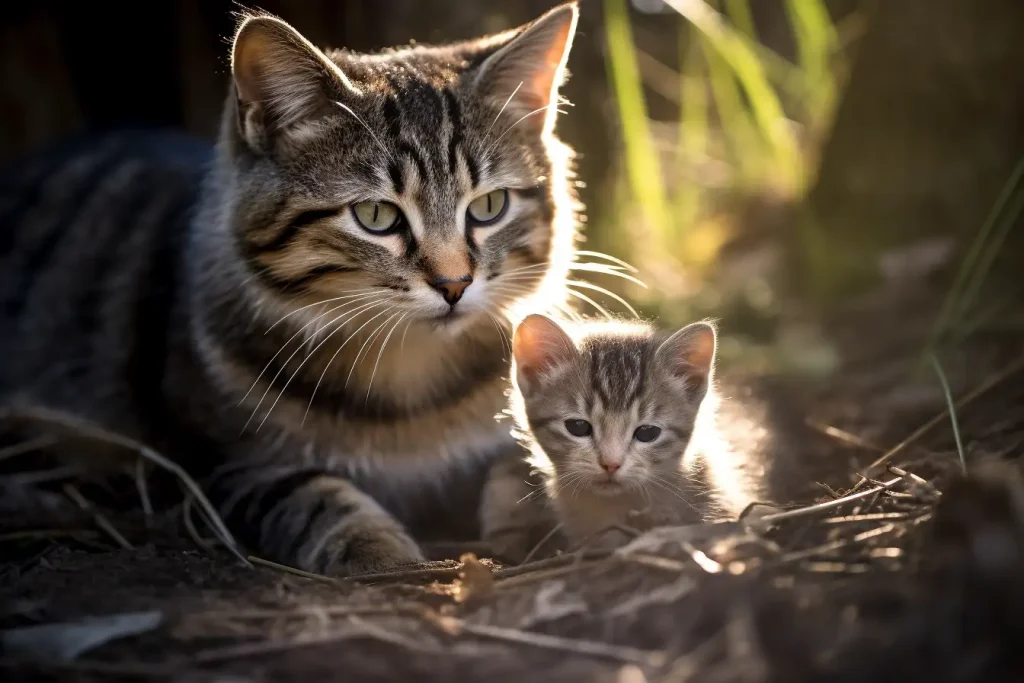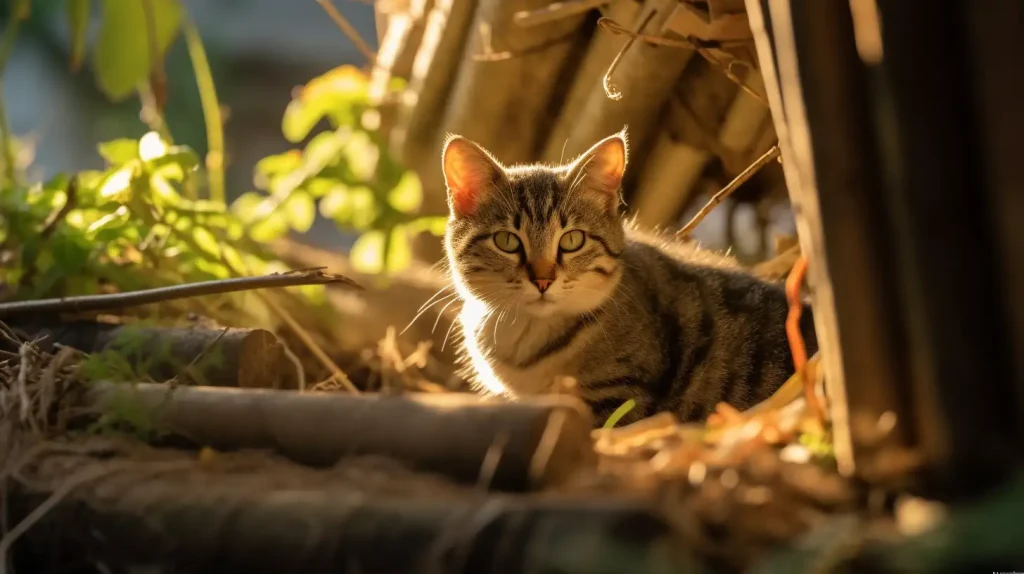Table of Contents
Figuring out what to do with a stray cat is tough enough under normal circumstances. Pregnancy just adds another layer of challenges to work through. Do you try to help a pregnant cat, or do you leave her to fend for herself? Do you attempt to get her to the vet for a physical? Well, none of these questions can be answered until you first establish that the cat is indeed pregnant.
The good news is that a stray cat will exhibit the same signs of pregnancy as a house pet or feral cat. If you know how to spot pregnancy in one kind of cat, you can spot it in all of them. I will discuss in more depth further on in the content, but…
You can tell that a stray cat is pregnant by: the slightly enlarged, darkened nipples, a swollen belly, more prominent hips, eating and sleeping more than usual, and, perhaps more tellingly, the ‘nesting’ instinct becomes more apparent toward the end of pregnancy.
Before I get to the signs of pregnancy, you should know that the gestation period for domesticated cats is about nine weeks. That’s it. So unlike humans, the signs of pregnancy begin manifesting themselves almost immediately after impregnation. Your powers of observation will determine how well you spot the signs in the early days of pregnancy.
Note that the first couple of signs relate to behaviors that would indicate a female cat is in heat. I include them for one simple reason: if you do observe a cat in heat then it is wise to begin looking for the signs of pregnancy soon after heat concludes. With that said, before we get to the main point of this article, we need to first understand the typical behavior of stray cats.
Understanding the Stray Cat’s Behavior
Before delving deeper into identifying the signs of pregnancy in a stray cat, it’s crucial to understand their typical behavior. Stray cats, unlike domesticated cats, have a different set of behaviors as they often need to fend for themselves and survive in the wild.
Stray cats are often more skittish, secretive, and less likely to approach humans. They’re nocturnal by nature, meaning they’re more active during the night when it’s quieter and safer for them to hunt and explore. As such, it can be challenging to observe their behavior and physical changes closely. This understanding is crucial when monitoring for signs of pregnancy, which might require you to observe them at odd hours or from a safe distance.
Additionally, stray cats have more pronounced mating behaviors compared to domestic cats. These behaviors are often visible during their heat cycles. Typical behaviors can include more vocalizing, increased rubbing against objects, and more visible signs of restlessness. Recognizing these patterns and distinguishing them from pregnancy signs can be vital in correctly identifying a pregnant stray cat.
Observing the subtle changes in their routine and behavior over time is the key to determining whether a stray cat might be pregnant. Knowing what is ‘normal’ for the stray cat you’re observing will help you pick up on any deviations that might signal pregnancy. By familiarizing yourself with the stray cat’s behavior, you’ll be in a much better position to identify the signs of pregnancy when they appear.

1. Temperature-Related Behavioral Changes
Female cats reach fertility as early as four months of age, though it is typically closer to six months. A cat need only reach about 80% of her adult body weight in order for her estrus cycle to begin. So that’s the first thing to consider.
You may not know exactly how old the cat is, but if it looks large and heavy enough to be an adult, then it is likely the cat is able to reproduce. This suggests that you should watch for changes of behavior related to the temperature.
Cats can go into heat multiple times per year. It really depends on local climate. Heat is very much linked to the outside temperature, so most cats in northern climates will not even begin the estrus cycle until the later days of spring. Then they can go into heat multiple times through summer and into fall.
If you notice unusual behavior by a stray cat – especially when it’s warm outside – that’s a good indicator she is in heat. Also note that a cat’s cycle can last as little as one day or as many as seven.
2. Heat-Related Behaviors
This brings us to the actual behaviors you should be looking for. A cat in heat will exhibit a number of behaviors, beginning with what appears to be especially affectionate behavior. Around humans, a cat in heat will rub up against legs more frequently and for longer periods of time. In the absence of humans, the animal will take its rubbing behavior to inanimate objects like rocks, trees, furniture, or anything else it finds suitable.
Another heat-related behavior is rolling on the ground more frequently than normal. Along with this behavior, a cat in heat will raise her rear quarters and attempt to tread with her legs while on her back. As heat progresses, she will begin to howl. The howling can become quite loud and intense.
Finally, a stray cat will urinate more frequently if she is in heat. She’s doing this in order to let any toms in the area know she is ready to mate. So watch for frequent urination around the yard.
3. Pinking Up
As a cat’s breasts and nipples begin enlarging in anticipation of the arrival of kittens, they become more visible through the animal’s fur. This is known as ‘pinking up’. It is really hard to miss in the later stages of pregnancy. The process of pinking up usually begins somewhere between days 15 and 18. You’ll know it as soon as you see it.
During the early stages of pinking up, you’ll probably only notice that the cat’s nipples have turned pink and can be easily seen through the fur. By the fourth or fifth week though, you should begin to see the breasts and abdomen enlarge. If you see her standing on all fours you should notice two bulges on her underside. The upper bulge is that of her breasts while the lower one is her belly. The belly bulge should hang lower.
The belly bulge will obviously grow bigger as the cat progresses through pregnancy. Her breasts should reach a certain size and then stop growing beyond that.

4. More Prominent Hips
Just like in human beings, the hips of a pregnant cats become more pronounced as pregnancy progresses. This is in preparation for delivery. You should notice more prominent hips whenever the cat is standing all fours. They will be especially noticeable from behind.
5. Movements in the Abdomen
From about 5 to 6 weeks it is possible to see movement in the cat’s belly. You know what this is: it’s those kittens moving around inside. You can confirm pregnancy if the cat is willing to let you get close enough to put your hand on her belly. Otherwise, you should be able to visually observe the movement as the day of delivery gets closer.
6. Increased Eating and Sleeping
A pregnant cat is a lot like a human mother in terms of eating habits. Simply put, a pregnant cat needs more calories. She will eat more often as a result. Some pregnant cats have voracious appetites that seem to never be satisfied. The cat may always be looking for more food.
If you decide to feed a stray cat, pay attention to how often she begs for food. If she begs a lot, eats it all, and starts putting on weight in the abdomen, you may have a pregnancy on your hands.
Hand-in-hand with increased eating is more sleep. Cats already sleep excessively compared to other animals, but a pregnant cat will sleep even more. The further along she gets, the more time she will spend sleeping. That leads us to the final sign: nesting.
7. The Nesting Instinct
Most female mammals have a built-in nesting instinct that begins displaying itself during the final days of pregnancy. You can observe this instinct in a stray cat by paying attention to where she spends most of her time. The nesting instinct tells her to find a safe, quiet place to give birth.
Let’s say the cat in question normally spends a lot of time hanging around your back porch. If she’s pregnant, more of her time will be spent elsewhere. Follow her at some point and see where she goes. If it appears as though she is looking for quiet solitude, pay attention to how much time she spends there. If she is pregnant, she’ll spend more time in her quiet place the further along she progresses.
Beware of False Pregnancy in Stray Cats
It’s important to remember that while you may observe all seven signs listed above in a stray cat, there’s no guarantee she’s pregnant. There’s a possibility she might be experiencing a phenomenon known as ‘false pregnancy’, more formally referred to as pseudopregnancy. This condition is relatively more common in dogs but can also occur in cats.
False pregnancy happens when a non-pregnant female cat exhibits behaviors and physical signs associated with pregnancy. Although the exact causes are not entirely understood, some theories suggest it might be due to a hormonal imbalance or a symptom of an underlying condition in the ovaries or uterus. Irrespective of the cause, dealing with a cat under false pregnancy requires understanding and patience.
Symptoms of false pregnancy in a stray cat can include:
- Behavioral changes
- Self-nursing
- Restlessness
- Abdominal distention
- Enlarged breasts
- Vomiting
- A brown, watery discharge from the nipples.
These symptoms can closely mimic those of a genuine pregnancy, with vomiting and nipple discharge standing out as unique indicators of false pregnancy.
Impact on the Cat’s Health and How to Handle the Situation
False pregnancy doesn’t typically cause a serious health issue for a cat, but it can be a stressful experience for her. The cat may show signs of discomfort or distress due to hormonal changes and the physical manifestations that accompany them, such as enlarged breasts and abdominal distention. Also, recurrent episodes of false pregnancy might indicate a more serious underlying medical condition requiring veterinary attention.
The behavioral changes associated with false pregnancy, like restlessness, could lead the cat to behave erratically or become more reclusive. During this time, it’s crucial to ensure the cat feels safe and is not subjected to unnecessary stress.
It’s also important to note that you should avoid attempting to self-diagnose or treat a cat you suspect is experiencing a false pregnancy. Instead, if it’s feasible, consider consulting with a vet who can make an accurate diagnosis based on professional knowledge and advanced tools.
While most false pregnancies resolve themselves without intervention, a vet may advise treatments to manage the condition, especially if the cat shows signs of distress or discomfort. Treatments could range from hormone therapy to address any imbalances to spaying the cat to prevent future pseudopregnancies. If an underlying condition like ovarian cysts or uterine abnormalities is discovered, the vet might recommend further treatments or surgeries.

The Dangers of False Pregnancy in Stray Cats
Understanding False Pregnancy
One fascinating but often misunderstood phenomenon is false pregnancy, sometimes referred to as ‘pseudopregnancy.’ It is a condition where a non-pregnant cat exhibits behavior and physical changes usually associated with pregnancy. While it is far more common in dogs, cats can experience it as well, which can lead to a significant amount of confusion, for both the cat and those caring for her.
The Stress of Pseudopregnancy
False pregnancy in a stray cat can be distressing for the animal. Imagine the confusion a cat experiences when her body is telling her she is pregnant, yet there are no kittens on the way. This can lead to behavioral changes that are taxing on the cat’s emotional and physical health, such as increased restlessness, self-nursing, and even nest-building behaviors.
Physical Strain of False Pregnancy
From a physical standpoint, false pregnancy can cause uncomfortable and sometimes alarming symptoms for the cat. This includes abdominal distention, enlarged breasts, vomiting, and even a watery, brown discharge from the nipples. Such symptoms can significantly decrease a cat’s overall quality of life, leading to potential weight loss, exhaustion, and vulnerability to other illnesses due to a compromised immune system.
Interference with Regular Estrus Cycle
In some cases, false pregnancy can interfere with a cat’s normal estrus, or heat, cycle, leading to further confusion and hormonal imbalance. This might also have an impact on a cat’s future reproductive health, potentially leading to complications if the cat becomes pregnant later on.
It is essential, therefore, to pay close attention to a stray cat exhibiting signs of pregnancy. Understanding the possibility of a false pregnancy can help ensure that she gets the care she needs, either through observation and provision of a comfortable environment or, if possible, by getting her to a vet for a professional diagnosis.
Clinical Diagnosis of False Pregnancy
If you suspect that a stray cat is experiencing a false pregnancy, there are essentially two options. One is to monitor the cat’s behavior and physical changes, waiting to see if she indeed gives birth. However, this method does not provide a definitive answer until the supposed gestation period passes, and it could potentially delay necessary medical assistance if the cat is indeed facing a health issue.
The alternative is to capture the cat safely and take her to a vet. This should be done with caution, considering the unpredictable behavior of stray cats. Employing a trained professional or using humane traps could be the best course of action.
Physical Examination
Once at the veterinary clinic, the vet will conduct a comprehensive physical examination to assess the cat’s condition. This examination might include palpating the abdomen to feel for the presence of kittens, or examining the cat’s mammary glands for signs of lactation. The vet will also likely ask for information about the cat’s behavioral changes and the timing of these changes. Providing as much information as possible, even if it’s just observational, can be helpful.
If the physical examination is inconclusive, the vet may order blood tests. These tests can assess the cat’s overall health and look for hormonal changes indicative of pregnancy or false pregnancy. For instance, a high level of the hormone progesterone could suggest pregnancy, although it can also be present during false pregnancies.
Urine tests might also be conducted. These tests can help rule out urinary tract infections and other health conditions that might cause similar symptoms to pregnancy or false pregnancy.
Imaging Techniques
If further investigation is needed, the vet may use imaging techniques. An ultrasound scan can detect a pregnancy as early as 2 weeks into the gestation period, and it can provide a clear view of the uterus, enabling the vet to see if kittens are present. X-rays can also be used, but they are generally only effective later in the pregnancy, when the kittens’ bones have developed enough to be visible (usually after 45 days).
In the case of false pregnancy, the ultrasound and X-rays would not show any kittens, despite the cat showing physical signs of pregnancy. Blood tests might show hormonal imbalances, and the physical examination might reveal enlarged mammary glands without the presence of milk.
It’s important to note that conducting these tests and consultations with a vet will come with costs. The price can vary depending on the tests needed and your location. It’s also worth noting that while you can decline any treatment or tests, doing so might leave you without a clear understanding of the cat’s condition. Furthermore, if the cat is indeed pregnant or is experiencing a false pregnancy due to a medical issue, refusing treatment could potentially harm her health.
Thus, deciding to involve a vet should come with the understanding of potential costs and the readiness to deal with the findings, whether it be a real pregnancy, a false pregnancy, or an underlying health issue manifesting as a false pregnancy.

How to Approach a Pregnant Stray Cat Safely
Encountering a stray cat, particularly one that could be pregnant, can be a moving experience. You may be overwhelmed with a desire to help, but remember that proper approach and handling is crucial. Stray cats are not typically used to human interaction, and a sudden approach might cause them to become defensive or fearful, which could lead to injury.
Start by observing from a distance. Try to assess the cat’s behavior and condition. If the cat seems aggressive or overly scared, it might be best to seek professional help from local animal control or a cat rescue organization. It’s important not to corner or trap the cat, as this can escalate the situation and lead to panic or aggressive responses.
Establishing Trust with the Cat
If the cat seems calm, you can gradually try to establish trust. One effective method is to offer food. Place it a fair distance away from you and the cat, then slowly retreat. Allow the cat to approach the food on its own terms. This non-threatening gesture could be the start of building trust.
During these initial interactions, avoid direct eye contact as cats often interpret this as a sign of aggression. Instead, blink slowly at the cat. This is known in the feline world as a ‘cat kiss’ and is a sign of trust and friendliness.
Once you’ve gained the cat’s trust through repeated feeding and non-threatening behavior, you may be able to get closer. Remember to move slowly and speak in a calm, soft voice. It’s key to let the cat dictate the pace of this process.
Remember, pregnant cats have protective maternal instincts, and stray cats are not accustomed to human interaction, so patience and care are paramount in these situations.
How to Care for a Pregnant Cat
I have prepared a comprehensive guide explaining how to care for a pregnant cat. I urge you to take a look at it if you have determined that your care-giving services are going to be necessary.
Caring for a pregnant cat, especially a stray, can be challenging but extremely rewarding. Here are some comprehensive tips:
Arrange a Veterinarian Visit
If possible, try to bring the stray cat to a vet for a health examination. The vet can confirm pregnancy, give you an estimate on the due date, and assess the cat’s overall health. If there are any health issues, such as parasites or malnutrition, the vet can guide you on how to handle them. If getting the cat to a vet isn’t possible, observe the cat for any signs of illness or distress and consider reaching out to local animal welfare organizations for support.
Nutritional Support
Pregnant cats need extra nutrition to support their growing kittens. Provide a diet rich in proteins and essential nutrients. It is often recommended to feed pregnant cats kitten food, as it has higher nutritional content. Make sure she has access to fresh water at all times.
Creating a Safe Space
Stray cats often prefer quiet, secluded places. Create a comfortable and safe space where the cat can rest and eventually give birth. This could be a spare room in your home or a sheltered, insulated space outside if bringing the cat indoors isn’t feasible. The space should be warm, quiet, and free from hazards.
Beware of Flea Treatments
While flea infestations should be treated for the health of the cat and her unborn kittens, some flea treatments can be harmful during pregnancy. Consult a vet before applying any flea treatments to a pregnant cat.
Monitor for Signs of Labor
Cats usually manage birthing on their own, but complications can occur. Learn the signs of labor in cats, such as restlessness, nesting behavior, and loss of appetite. It’s also crucial to be aware of signs of distress or complications like strong contractions without kitten birth, excessive bleeding, or extreme lethargy.
Potential Need for Intervention
In some cases, you may need to intervene during birth, especially if the cat appears to be in distress or a kitten seems stuck. If you feel intervention is needed, it’s best to consult with a vet or a cat birthing expert to guide you through the process safely.
Remember, your care for this stray pregnant cat goes a long way in ensuring she and her kittens have a chance at a healthy life. If the stray cat you’ve been observing is indeed pregnant, you’re in for a rewarding journey, and you might soon be greeted by the pitter-patter of tiny paws.

The Importance of Neutering/Spaying Stray Cats
Managing Stray Cat Populations
In the world of feline welfare, there’s a topic that often receives a great deal of attention: the neutering and spaying of stray cats. Stray cats, often known as ‘community cats’, are a familiar sight in many neighborhoods and cities. In fact, there are an estimated tens of millions of stray cats roaming around in the U.S. alone. The challenges associated with this situation are numerous, ranging from public health concerns to negative impacts on wildlife.
One of the key strategies to manage this issue is the practice of spaying (for female cats) and neutering (for male cats). This surgical procedure renders cats unable to reproduce, directly controlling the growth of the stray cat population. By preventing unwanted litters, we’re not just limiting the number of cats on the streets, but also reducing the chances of cats contracting diseases or facing hardship due to insufficient resources.
Avoiding the Challenges of Stray Cat Pregnancies
Stray cat pregnancies can be particularly challenging. Pregnant strays often face many health risks due to inadequate nutrition, the presence of parasites, and the lack of a safe and clean environment for birthing and rearing kittens. Moreover, the presence of newborn kittens can attract predators, creating a dangerous situation for both the mother and her offspring.
Neutering and spaying is a preventive measure that can mitigate these challenges. It prevents pregnancies, eliminating the associated risks, and allowing cats to live healthier, safer lives. It also reduces behaviors associated with mating, such as spraying, yowling, and fighting, making the cats better neighbors in our communities.
Role of the Community
Taking responsibility as a community plays a vital role in this endeavor. Through programs such as Trap-Neuter-Return (TNR), community members, in collaboration with local animal welfare groups, can work together to neuter and spay stray cats, then return them to their territory. This humane and effective approach can make a significant difference in managing stray cat populations and improving the overall health and safety of these cats.
How to Tell if a Stray Cat is Pregnant – Conclusion
In conclusion, identifying a pregnant stray cat requires careful observation and understanding of their behavior. It’s important to provide pregnant strays with proper care, nutrition, and a safe space to give birth. Spaying and neutering is a crucial preventive measure that can mitigate the challenges associated with stray cat pregnancies and control their population. As a community, we can take responsibility and work together to ensure the well-being of stray cats and reduce the negative impact on their lives and environment.
Key Takeaways
- Detecting pregnancy in stray cats requires careful observation and understanding of their behavior.
- Movements in the abdomen can indicate pregnancy in cats, but it’s important not to scare or harm the cat during this process.
- Building trust with the cat through non-threatening gestures, such as offering food, can help establish a closer relationship and facilitate care.
- Pregnant stray cats face many health risks due to inadequate nutrition and the lack of a safe birthing environment, among others.
- Spaying and neutering is a crucial preventive measure that can mitigate the challenges of stray cat pregnancies and control their population.
- Preventing unwanted litters also reduces the risks of diseases and hardships due to insufficient resources.
- As a community, we can take responsibility and work together to ensure the well-being of stray cats and reduce the negative impact on their lives and environment.
- Neutering and spaying also reduces behaviors associated with mating, making the cats better neighbors in our communities.
COPYRIGHT NOTICE
Please be advised that all images, designs, and creative content on this page are the exclusive property of Stray-Cat-Advice.com and are protected under international copyright laws. The images may not be reproduced, copied, transmitted or manipulated without the written permission of stray-cat-advice.com.
Unauthorized use, distribution, display, or creation of derivative works of any images contained on this site, is strictly prohibited and can lead to legal penalties. We actively monitor for, and enforce, our copyright interests.
If you wish to use any of our images, kindly contact us to seek permission. Respect of copyright is not merely a legal requirement but also an acknowledgement and support of the hard work and creativity that goes into producing them.
Thank you for your understanding and cooperation.
© 2023, stray-cat-advice.com. All Rights Reserved.



